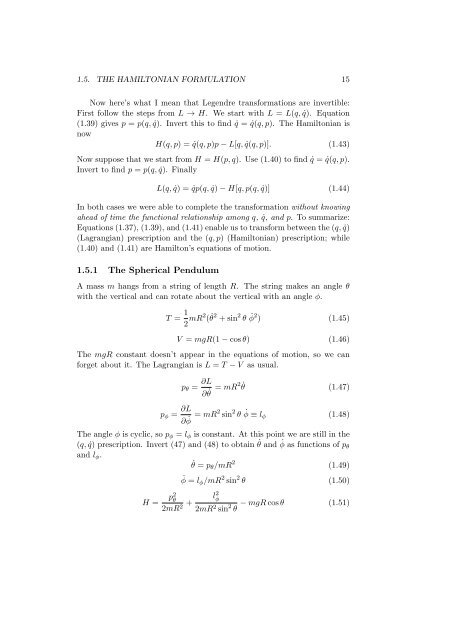Nonlinear Mechanics - Physics at Oregon State University
Nonlinear Mechanics - Physics at Oregon State University
Nonlinear Mechanics - Physics at Oregon State University
You also want an ePaper? Increase the reach of your titles
YUMPU automatically turns print PDFs into web optimized ePapers that Google loves.
1.5. THE HAMILTONIAN FORMULATION 15<br />
Now here’s wh<strong>at</strong> I mean th<strong>at</strong> Legendre transform<strong>at</strong>ions are invertible:<br />
First follow the steps from L → H. We start with L = L(q, ˙q). Equ<strong>at</strong>ion<br />
(1.39) gives p = p(q, ˙q). Invert this to find ˙q = ˙q(q, p). The Hamiltonian is<br />
now<br />
H(q, p) = ˙q(q, p)p − L[q, ˙q(q, p)]. (1.43)<br />
Now suppose th<strong>at</strong> we start from H = H(p, q). Use (1.40) to find ˙q = ˙q(q, p).<br />
Invert to find p = p(q, ˙q). Finally<br />
L(q, ˙q) = ˙qp(q, ˙q) − H[q, p(q, ˙q)] (1.44)<br />
In both cases we were able to complete the transform<strong>at</strong>ion without knowing<br />
ahead of time the functional rel<strong>at</strong>ionship among q, ˙q, and p. To summarize:<br />
Equ<strong>at</strong>ions (1.37), (1.39), and (1.41) enable us to transform between the (q, ˙q)<br />
(Lagrangian) prescription and the (q, p) (Hamiltonian) prescription; while<br />
(1.40) and (1.41) are Hamilton’s equ<strong>at</strong>ions of motion.<br />
1.5.1 The Spherical Pendulum<br />
A mass m hangs from a string of length R. The string makes an angle θ<br />
with the vertical and can rot<strong>at</strong>e about the vertical with an angle ϕ.<br />
T = 1<br />
2 mR2 ( ˙ θ 2 + sin 2 θ ˙ ϕ 2 ) (1.45)<br />
V = mgR(1 − cos θ) (1.46)<br />
The mgR constant doesn’t appear in the equ<strong>at</strong>ions of motion, so we can<br />
forget about it. The Lagrangian is L = T − V as usual.<br />
pθ = ∂L<br />
∂ ˙ θ = mR2 ˙ θ (1.47)<br />
pϕ = ∂L<br />
∂ ˙ ϕ = mR2 sin 2 θ ˙ ϕ ≡ lϕ<br />
(1.48)<br />
The angle ϕ is cyclic, so pϕ = lϕ is constant. At this point we are still in the<br />
(q, ˙q) prescription. Invert (47) and (48) to obtain ˙ θ and ˙ ϕ as functions of pθ<br />
and lϕ.<br />
˙θ = pθ/mR 2<br />
(1.49)<br />
H = p2 θ +<br />
2mR2 ˙ϕ = lϕ/mR 2 sin 2 θ (1.50)<br />
l2 ϕ<br />
2mR2 sin2 − mgR cos θ (1.51)<br />
θ
















